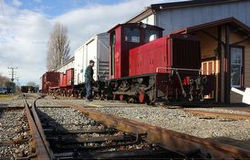

 |
|---|
 |
 |
 |
The Schools carriage
'A' 717 was one of a batch of ten second-class carriages built at the Hillside Workshops between 1901 and 1902. It entered service in the Dunedion region in 1902. For many years it was used to transport school children into Dunedin; hence the name given to it by the Pleasant Point Railway.
In April 1956 it was converted into a mobile workshop and reclassified 'Ea' 2893. It remained as such until purchased by the Pleasant Point Railway in 1983 for $190.
The carriage was trucked from Washdyke to Pleasant Point on 23 July 1983 and restored in time to be placed in service on 27 December 1983. It is representative of a class of carriages known as 'turtlebacks'.
It is now awaiting its second restoration.
 |
|---|
 |
 |
 |
 |
 |
 |
 |
 |
 |
The leslie wain carriage
'A' 421 is unique, being the only fully restored 'half birdcage' carriage in New Zealand. Built-in the New Zealand Railways Addington Workshops in Christchurch in 1895, it commenced service on 12 October of that year in the Christchurch region as a first-class saloon balcony carriage.
During 1905, 'A' 421 was transferred to the Invercargill region. In the years that followed, it was reduced to a second-class carriage before eventually being written off in 1955. Three years later it was sold as a bach (holiday home) in the small township of Mt. Somers. It was donated to the Pleasant Point Railway in 1977 by trustees of the late Leslie Wain and trucked to Timaru in 1980. While in Timaru, it was placed on the underframe and bogies of carriage 'A' 529.
During June 1984, the carriage was trucked out to Pleasant Point for partial restoration to allow it to take an active in the filming of the pilot film on the life of Ald Hanton, and in particular, his defence of Minnie Deans, the only woman to have been hanged in New Zealand.
The filming took place at Ashburton and Weka Pass and necessitated its return to the New Zealand Railways main line. on its return to Pleasant Point in October 1984, the restoration was completed in time for it to enter service on 28 December 1984. the plush first-class seats, balcony grill (from which the term 'birdcage' is derived) and the clerestory roof sets this car out from the other marriages in the Pleasant Point Railway's collection.
 |
|---|
 |
 |
 |
The kakahu carriage
'A' 1142 was built at the New Zealand Railways Addington Workshops in 1911 as a 'Composite Day Car', having both first and second-class compartments. It entered service that same year and completed its service in the South Island. Converted to an all-second-class carriage in June 1943, it was written off in March in 1958 and sold to Mr. Scandrett in September 1958.
Eventually, it was transported to Kakahu where it was used as a sleep-out (overnight accommodation). It remained there until 1986 when a truck was used to remove it to Pleasant Point. The carriage body of "a' 1142 is now bolted onto the underframe of carriage 'A' 1548.
Restoration work began on 'A' 1142 in 1993, followed by another push at restoration 10 years ago. The majority of the work has been completed in the past three years.
Restoration team leader Don Spencer said the finishing touches were just days before the commissioning. "Everything looks nice and shiny. It all takes a long time when you are restoring old equipment."
He estimated more than 2000 hours had been spent on the project. "When you are sanding, varnishing and polishing old bits of brass, it's very time-consuming. It's come up pretty well considering it's 100 years old."
Mr Blanchard said 10 people worked on the restoration and more than $10,000 had been spent.
 |
|---|
 |
 |
the guardsvans
The society owns two 30-foot-long guardsvans. Both completed their service with New Zealand Railways in the South Island.
'F' 423 was built in the Hillside Workshops in 1915 and was purchased by the Society in 1980. It arrived in Timaru in July of that year and was restored to house the society's radio studio and associated equipment. Trucked to Pleasant Point in December 1980, it is now commonly referred to as Bill Timmings' van, in memory of the man who was the mastermind behind the radio studio idea.
'F' 510 was built at the Addington Workshops in 1929 and was given to the society by a member in 1982. It was stored on a Levels Valley farm until January 1984, when it was trucked to Pleasant Point for restoration. This van entered service at Pleasant Point on January 13, 1985, and is now a permanent part of the passenger carriage set.
 |
|---|
 |
 |
 |
 |
The Freight Wagons
Over the years the Society has collected a representative collection of older freight wagons - many synonymous with the Fairlie branch line. These include a sheep wagon ('Jc' 5051), meat wagon ('Xb' 2153), wooden and steel general purpose wagons ('M' 225 and 'La' 24598 respectively), steel box wagon ('Kp' 2626), beer crate wagon ('Ubw' 61), general purpose wagon ('Nc' 1053), ballast wagon ('Yb' 579) and horse box ('Ug' 125). The horse box was converted in 1977 to carry passengers.
Within the past few years, a second 'Kp' steel box wagon, now painted silver, has been added to the collection, as well as a 'Na' flat deck wagon, which is used for storing wood.
All the wagons are restored and many are displayed in the Keanes Crossing shed. From time to time they are used for demonstrating purposes behind 'Ab' 699 or 'D' 16.